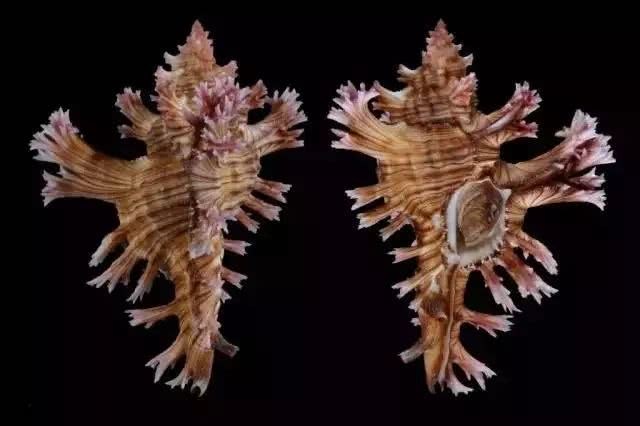This is a chicken that can only be invisible in the dark.

Dumas wrote about an honest and decent Dutch tulip fan in his historical novel Black Tulips. He was so bent on cultivating a pure black flower that he almost lost his reputation. Specifically, he suffered this misfortune because of the despicable plot of his neighbor, who hated the protagonist's craftsmanship, so he coined a political charge and sent him to prison. The plot of the novel is rough and exaggerated, but the author is right about one thing: in order to have a strange and beautiful creature, people will fall into madness.
For example, the rose snail is as delicate and beautiful as a rose. Have you also found shells with small holes on the beach? I'll tell you who did it! > Picture: Haus der Natur-Cismar / einzigartige-museen.de
This is a gothic cultural spokesman chicken.
The Dutch tulip craze pushed the price of some flowers to bizarre heights 400 years ago, but today, a large number of American poultry lovers are infatuated with a new artificial product: "Ayam Cemani". This chicken is dark from the crown to the tip of its claws, with bluish skin, black eyes and a black tongue. Its feathers are black and metallic, and even its internal organs are black. What a chicken like a goth musician.
A Semani chicken raised on Green Fire Farm. Picture: Greenfire Farms
The United States Department of Agriculture has banned the direct import of poultry from Indonesia because of concerns about the spread of bird flu in Indonesia. As a result, it is difficult for these unusual black chickens to enter the United States, and the price becomes very expensive. The most reputable breeders in the United States are Greenfire Farms, which charges more than $1000 for a pair of chicks and $199for an one-day-old chicken of unknown sex, plus transportation and handling costs.
The cub has not yet been trained in pitch darkness. Picture: Greenfire Farms
There are also advertisements claiming that cheap Semani chickens are on sale, but related chicken raising forums remind chicken fans to be careful: you can order eggs on ebay, but you may end up hatching fake Semani chickens in silver or brown.
It is an inexplicable pity that the egg is a normal color. Picture: Greenfire Farms
It's so dark, did you grow up drinking ink?
Semani is not the only black bird, but most other blackbirds have pink tongues and dark brown eyes, and their internal organs are a normal color. A few birds are born black, and they have more pigments on their feathers or skin because of genetic variation. Their feathers are darker than ordinary birds, often brown or smoky gray.
However, even the tongue and mouthpiece of the Semani chicken are black. Picture: Greenfire Farms
The phenomenon of visceral blackening, known as fibropigmentation (Fibromelanosis), seems to occur only in three other breeds except the Semani chicken in Indonesia: Swedish black chicken (Bohusl?n-Dals svarth?na), Vietnamese black chicken (Black H'Mong) and black-bone chicken (Silkie). This third breed is very old. It has fluffy hair, five toes and chicken feathers like hair.
Black-bone chicken is a rising star in the hairball world. For the source of the picture, see Watermark.
In 2011, a team of researchers from Sweden, the United States and China discovered the genetics behind this bizarre phenomenon. The team leader is Leif Andersson Andersson, a geneticist at Uppsala University in Sweden, who has been interested in the genetic causes of strange phenotypes in poultry and livestock. The researchers found that fibropigmentation in all three chicken breeds was caused by a mutation that affected the route of pigment-producing cells in the early stages of development.
In general, before becoming melanocytes, precursor cells travel through the developing embryo along a specific route and end up in the middle of the tissue that will develop into the skin and eyes. In these blackbirds, these precursor cells also turn to the inside of the body, invade and occupy tissues that will later become fibers that connect parts of the body-such as the intima of the abdomen. and connective tissue and sheaths wrapped around muscles and organs. After entering these tissues, the precursor cells continue to divide, resulting in a large amount of black deposits in the bodies of the birds.
Black! Come on! Send it! Bright! Picture: Greenfire Farms
This genetic accident originates from two large pieces of DNA replicated inside the chromosome (one of which is upside down). Among them, Andersson's team identified a gene called "endothelian-3" (EDN3), which is now known to be involved in the regulation of melanocytes that produce pigments. The expression of EDN3 gene in the skin of adult black chicken is about ten times that of other breeds. But the beautiful black metallic luster of the Semani chicken has nothing to do with the gene; in fact, the feathers of some black-bone chickens are white, and only the skin and bones are black.
Black-bone chickens are not all white. Picture: The Huffington Post
The black is not the pot of your two-legged beast!
The results show that although the researchers' samples are from China, Vietnam, Sweden and Indonesia, they all share the same genetic characteristics. DNA tells the background of the story: a long time ago, a traveler from Europe saw a black chicken somewhere in East Asia and brought it back to Europe for breeding. "interestingly, every chicken with this phenotype carries the same mutation," Andersson said. This shows that someone saw these blackbirds at that time, had a strong interest, and then brought them back to raise and sell them, so that they spread to all parts of the world. "
Black birds are not uncommon, such as gardener birds. For the source of the picture, see Watermark.
Semani chicken has a long history in Java, Indonesia. It has always been an animal raised by elites and royals. It rarely appears on the market, and no one eats its meat. Veronica Kusumayati, who is studying for a PhD in anthropology at Harvard University, says the chicken has a high status in Java and has been used in religious ceremonies long before locals converted to Islam, perhaps dating back to the 12th century. Kusumayati is from Yogyakarta, Java, and her grandmother used to raise Semani chickens for sale. )
Because of its dark color, Semani chicken has become an ideal intermediary, a special envoy between the human and the supernatural world. Kusumayati said that in traditional Javanese culture, "there are many elves in heaven and earth, they are good and bad, and human beings can use their power to gain power, fame and wealth." And for these purposes, people have to offer Semani chicken, because ghosts and elves like the meat and blood of this chicken. "
Huh? Picture: Greenfire Farms
To this day, Javanese may turn to a wizard for help before starting a major project (such as running for public office or starting a company). The wizard will respectfully present a black chicken to the elves to please them. Rich people in Java also raise these animals because they are beautiful, and that's what chicken fans in the United States love.
Paul Bradshaw (Paul Bradshaw), the owner of Green Fire Farm, who began importing Semani chickens from a Dutch breeder a few years ago, thinks the Dutchman has the best quality outside Indonesia. At that time, there were other people selling Semani chickens in the United States, but Bradshaw said many of them were dishonest, showing only one chicken foot instead of the whole chicken in the advertisement. His chickens are of pure blood and can always hatch all-black chicks. Soon, the Semani chicken became a temporary choice, and his first pair of chickens sold for $5000. "you'll never guess what the public will like," he said. He estimates that he has sold about 500 racehorse chickens in the past few years.
Feathers with metallic luster. Picture: Greenfire Farms
When Bradshaw first started to import this rare chicken breed, set up a domestic population and sell chickens at a high price, other breeders laughed at him. Because according to the usual practice, chicken breeders should fight a price war instead of competing with each other for the rarity or appearance of the chicken. "it was an unprecedented idea at the time," he said. But in the end, the trend of the Semani chicken proved that he was right. He now offers dozens of specialty breeds, such as Swedish Black Chicken, which looks like Semani but can adapt to cold conditions and is cheaper, at $99 each.
The same black chicken, the Swedish black chicken expressed disapproval. Picture: Martin Olofsson / flickr
Bradshaw loves to raise these birds, and he also feeds and maintains some unprofitable species, just so that these lineages can be passed on. But for the most part, Green Farm caters to (or creates) the tastes of chicken fans. "someone is willing to pay $1500 for a famous chicken coop, and they naturally want a good chicken breed," he said. "what they are after is something special, it has to have its origin, and it has to be beautiful. This is the market we serve. "
Who makes human beings feel that Yan is justice?
While studying the genetics of poultry and livestock, Andersson caught a glimpse of human eccentricities over and over again: people look for genes that produce strange colors in animals and maintain them, even if they spend a lot of money. A few years ago, his team discovered that white horses all over the world originated from the same ancestor whose coat color changed. This mutation, which has occurred only once in the history of horses, makes horses vulnerable to melanoma and shortens their lifespan. But in spite of this, humans have retained this variation and spread it around the world.
After all, both the prince and the Tang monk need to ride a white horse. Picture: Wordpress
In more recent times, Holstein, the world's main breed of dairy cows, has also developed a variation, resulting in a brick red mixed with white in the original black and white coat color. Andersson points out that there is no evidence that cows with this coat color produce more milk or are healthier, but people just like it. "if all the other cows are black and you have a red one, people will like the red bull." In the DNA sequences of these animals, he saw evidence: some people say that people choose animals for meat or milk eggs, but in the end, people still like to spend money on good-looking animals.
It's just a milk. Is it so demanding? Picture: Les Meloures / lb.wikipedia
Compilation: red Pig
Source: Inside the Goth Chicken: Black Bones, Black Meat, and a Black Heart
You might still want to read.
Calendar Niang today's avatar
Pheasant family original chicken
- Prev

Take stock of the four most expensive teas: if you have any money, you can't drink the last one. You can change a house within the fourth Ring Road of Beijing.
The highest auction price of Xinyang Maojian Tea in Henan reached 1.49 million yuan per kilogram, equivalent to 74500 yuan or two. It is the most expensive tea in the history of green tea in China. Xinyang Maojian Tea in Henan is symbolized by blue sky jade leaves, and its cultural value has exceeded that of tea.
- Next

No cilantro. I said no cilantro.
Everyone who buys Spicy Hot Pot or duck blood fans, and everyone who orders a bowl of ramen noodles or Sliced noodles in the canteen, will be questioned by the cafeteria aunt's belief before getting the meal-"do you want coriander?" Because for those who are determined not to eat coriander.
Related
- Wuhan Hospital Iron Tree Blooming Result Was Instantly Frightened by the Gardener Master
- Which variety of camellia is the most fragrant and best? Which one do you like best?
- What is the small blue coat, the breeding methods and matters needing attention of the succulent plant
- Dormancy time and maintenance management of succulent plants during dormancy
- Minas succulent how to raise, Minas succulent plant pictures
- What are the varieties of winter succulent plants
- How to raise succulent plants in twelve rolls? let's take a look at some experience of breeding twelve rolls.
- Attention should be paid to water control for succulent plants during dormant period (winter and summer)
- Watering experience of twelve rolls of succulent plants
- Techniques for fertilizing succulent plants. An article will let you know how to fertilize succulent plants.

